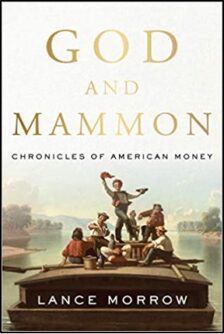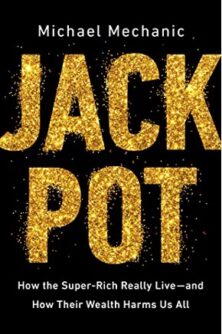A mid-year collection of interesting and insightful passages.
A backdoor approach
“Because the tax code allowed nonprofit organizations to run registration and turnout drives as long as they did not push a particular candidate, organizing ‘historically disenfranchised’ communities (as Carnegie described them) became a backdoor approach to ginning up Democratic votes outside the campaign finance laws that applied to candidates, parties, and political action committees.”
— Sasha Issenberg, The Victory Lab: The Secret Science of Wining Campaigns, reviewed in “The Carnegie Corporation in The Victory Lab: The Secret Science of Winning Campaigns,” February 5, 2021
Naïveté and effrontery
William Rogers Coe “advised me that he knew about the manuscript and had splendid tidings for me: namely, I could safely withdraw the book because he, Mr. Coe, had got the private assurance of President [Alfred Whitney] Griswold that great reforms at Yale were under way and that conservative principles were in the ascendancy: so why bother to publish a book that would merely stir things up? I gasped at the blend of naïveté and effrontery. But although I had observed the phenomenon I was not yet as conversant as I would quickly become with the ease with which rich and vain men are manipulated by skillful educators. As a matter of fact, men who are not particularly rich or vain are pretty easy to manipulate also.”
— William F. Buckley, Jr., introduction to 25th-anniversary edition of God and Man at Yale: The Superstitions of “Academic Freedom,” reviewed in “God and Man at Yale at 70, William Rogers Coe 50 years after his death, and manipulative elites ‘naïveté and effrontery,’” February 9, 2021
Two ways to achieve moral redemption
“How was American money to organize itself for good? Two schools of thought take shape. The first of them sought the moral redemption of American wealth by philanthropy. The second model sought to achieve that goal by means of government.
…
“The philanthropic model that was judged to be outmoded in the emergency of the New Deal returns, with a certain pertinence, and even a moral purity, in the globalized context of the 21st century. In the absence of a worldwide system of relief of the kind that Franklin Roosevelt invented for America, the global, supra-governmental designs of philanthropist billionaires like Bill Gates makes sense. They operate, at their best, with a flexibility and global range that is impossible, or far more difficult, for government aid programs or United Nations agencies.
“The Gates model—pooling billionaires’ enormous contributions to do targeted good on planetary scale—might globalize Cotton Mather’s American principle, the idea of two oars rowing to heaven. Gates’ notion is the enlistment of big money—the biggest—in a global performance of entrepreneurial good. If the model worked, the conflict between God and Mammon would wither away.”
— Lance Morrow, God and Mammon: Chronicles of American Money, reviewed in “God, mammon, and philanthropy,” February 11, 2021
Philanthropy and woke capital
The Sustainability Accounting Standards Board “wants very much to be the approved arbiter of what does and does not constitute ‘sustainable’ business practice.” It is, “more or less, an operation of Bloomberg LP. Bloomberg Philanthropies made its first grant to the organization in 2012 and continues its heavy support to this day.
…
Laurene Powell Jobs—“as a philanthropist, as an activist, as a businesswoman, as a political donor, and as a shareholder—has been among the most aggressively ‘progressive’ billionaires in the country, if not the world.
“She has used Emerson Collective and other organizations that she’s funded to push a variety of progressive causes, especially the case for coercing business to curb carbon emissions,” he continues, and she’s “a significant player in a variety of worlds—business, media, politics, tech—pursuing a hardcore Leftist tack in each.
…
And Marc Benioff “has donated to a number of organizations dedicated to achieving largely left-wing political and social ends, and has made an enormous production of having his company boycott states that pass laws that offend his political sensibilities. Having made his billions as a cutthroat capitalist, Benioff is now, more or less, a corporatist.”
— Stephen R. Soukup, The Dictatorship of Woke Capital: How Political Correctness Captured Big Business, reviewed in “Philanthropy in The Dictatorship of Woke Capital,” March 2, 2021
Nonprofit-board governance
Ken “Dayton warned of deficiencies in not-for-profit boards, where either the paid executive surrendered its powers to the chair, or where chairs and boards, volunteers one and all, gladly usurped executive responsibilities. …
“Dayton had a special warning for executives in the non-profit sector,” many of whom “said they didn’t want a board ‘looking over my shoulder, second-guessing me, reviewing my performance. To any such executive, he advised, ‘If you really want to build that institution into a dynamic force in society, they can do it so much more effectively if you have a dynamic, effective board.’ Supervision, review and challenge were essential elements in the path to good performance.”
— John Tusa, On Board: The Insider’s Guide to Surviving Life in the Boardroom, reviewed in “Ken Dayton on good nonprofit-board governance,” March 8, 2021
A juggernaut beholden to nobody
“[T]he way philanthropy is practiced in our country not only favors the rich, it can actually exacerbate the estrangement between rich America and poor America. … The “Big Philanthropy juggernaut” is “beholden to nobody” and “can amass unlimited assets and exist in perpetuity. … Big Philanthropy remains profoundly undemocratic, yet the public and our elected leaders rarely complain anymore.”
— Michael Mechanic, Jackpot: How the Super-Rich Really Live—and How Their Wealth Harms Us All, reviewed in “Like actual jackpots, Jackpot loses a little luster after a winning beginning,” April 8, 2021
Shift of the center of gravity
“Overall, the shift of the center of gravity from local chapter-based member associations and church congregations to foundations, foundation-funded nonprofits, and universities represents a transfer of civic and cultural influence away from ordinary people upward to the managerial elite.”
— Michael Lind, The Class War: Saving Democracy from the Managerial Elite, reviewed in “The causes and consequences of growing distrust between elites and non-elites,” May 11, 2021
Culture and the sources of wealth supporting it
“Given that many museums are so obviously a manifestation of private wealth, made possible by the accumulation of riches often spent for private as well as public benefit, it is not surprising that questions are increasingly being asked about the extent to which public culture is controlled and made possible by a small cadre of very wealthy individuals.
…
“The question that this debate opens up is how much visitors to museums should care [about], and take an interest in, the sources of wealth that have been deployed in the creation and expansion of museums … and how much they should disapprove of the dependency of museums on international capitalism.
…
“I do not have to admire the personalities of” certain very wealthy contributors to museums “or make a moral judgment on the sources of their private wealth to respect what they have done in terms of the public benefit of making their collections available. Art has been used ever since medieval chantry chapels to launder the reputation of the sinful and to buy their way into heaven.”
— Charles Saumarez Smith, The Art Museum in Modern History, reviewed in “Money, morality, and musea,” May 17, 2021
Philanthropy as part of the Wealth Defense Industry
“The number of WDI [Wealth Defense Industry] professionals serving the very rich grows higher if you include the charitable private foundations and donor-advised funds that are often part of an overall asset preservation strategy for the 0.1 percent.” There is a “separate body of research … documenting how the philanthropy of the very wealthy, while sometimes providing great public benefits, also serves as an extension of private wealth preservation, tax avoidance, and power wielding.”
WDI members “are not personally in the super-rich 0.1 percent themselves. They do not have the “material power” to be oligarchs in the classic sense. But many of them are handsomely paid, safely in the top ten percent of income earners in the US and UK, and they wield significant power themselves in our political systems. Some would argue that they and other high-salaried private-sector workers represent a unique set of class interests, distinct from the oligarchs.”
— Chuck Collins, The Wealth Hoarders: How Billionaires Pay Millions to Hide Trillions, reviewed in “Philanthropy, charity, and The Wealth Hoarders,” June 4, 2021
Charity and public programs of the nation-state
“[T]o accept a stylized picture in which private charity enters the Depression and the framework of a modern welfare state comes out at the other end, misses the complex politics over the division of labor itself. In addition to establishing the foundational components of a welfare state—a set of entitlements or rights—” policy battles of the time “transposed practices and templates from the world of charity into public programs. … From the exclusion of agricultural and domestic workers from core social insurance programs to the moral policing of women receiving Aid to Dependent Children, elements of what had been voluntary practice became embedded in public policy.”
— Elisabeth S. Clemens, Civic Gifts: Voluntarism and the Making of the American Nation-State, reviewed in “Revisiting benevolence, philanthropy, and identity in Civic Gifts,” June 11, 2021
Quite an effective planning grant
An Evelyn and Walter Haas, Jr. Fund planning grant supported Evan “Wolfson as he prepared to return to the San Francisco philanthropy … with both a strategy and a structure that would not have left marriage advocates as powerless as they had been” in previous setbacks in specific states around the country.
“Wolfson was able to define a singular objective: the ability for same-sex couples to marry across the United States of America. In practice, Wolfson had defined more than fifty distinct policy objectives. … Any marriage campaign would have to be slogged out” among the states and territories, “simultaneously in courts, legislatures, and at the ballot box ….
…
“The proposal Wolfson delivered to [Haas] sketched a single-issue national organization called Freedom to Marry, based on the campaign model that could support political and legal activity ….”
— Sasha Issenberg, The Engagement: America’s Quarter-Century Struggle Over Same-Sex Marriage, reviewed in “Philanthropy in Sasha Issenberg’s The Engagement,” June 21, 2021





